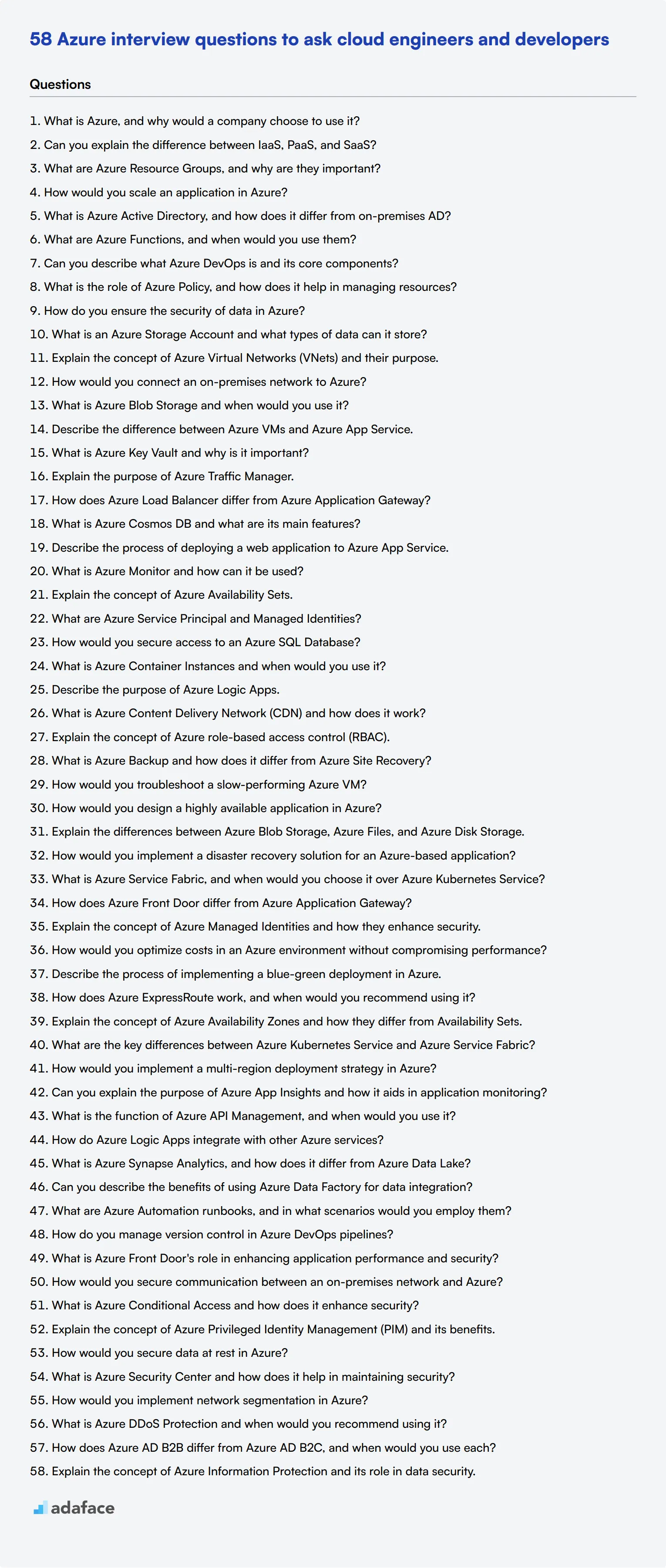Azure has become a dominant player in the cloud computing space, making it a necessary platform for many organizations. When hiring for Azure-related roles, it is important to assess candidates effectively to ensure they have the right skills and knowledge.
In this post, we will cover a comprehensive list of Azure interview questions tailored for various experience levels and topics. From general questions to more specific ones about services, architecture, and security practices, you'll find a range of questions to evaluate your candidates thoroughly.
Using these questions, you can streamline your interview process and identify the best talent for your team. Additionally, consider using Azure tests to further vet candidates before the interview stage.
Table of contents
9 general Azure interview questions and answers to assess applicants
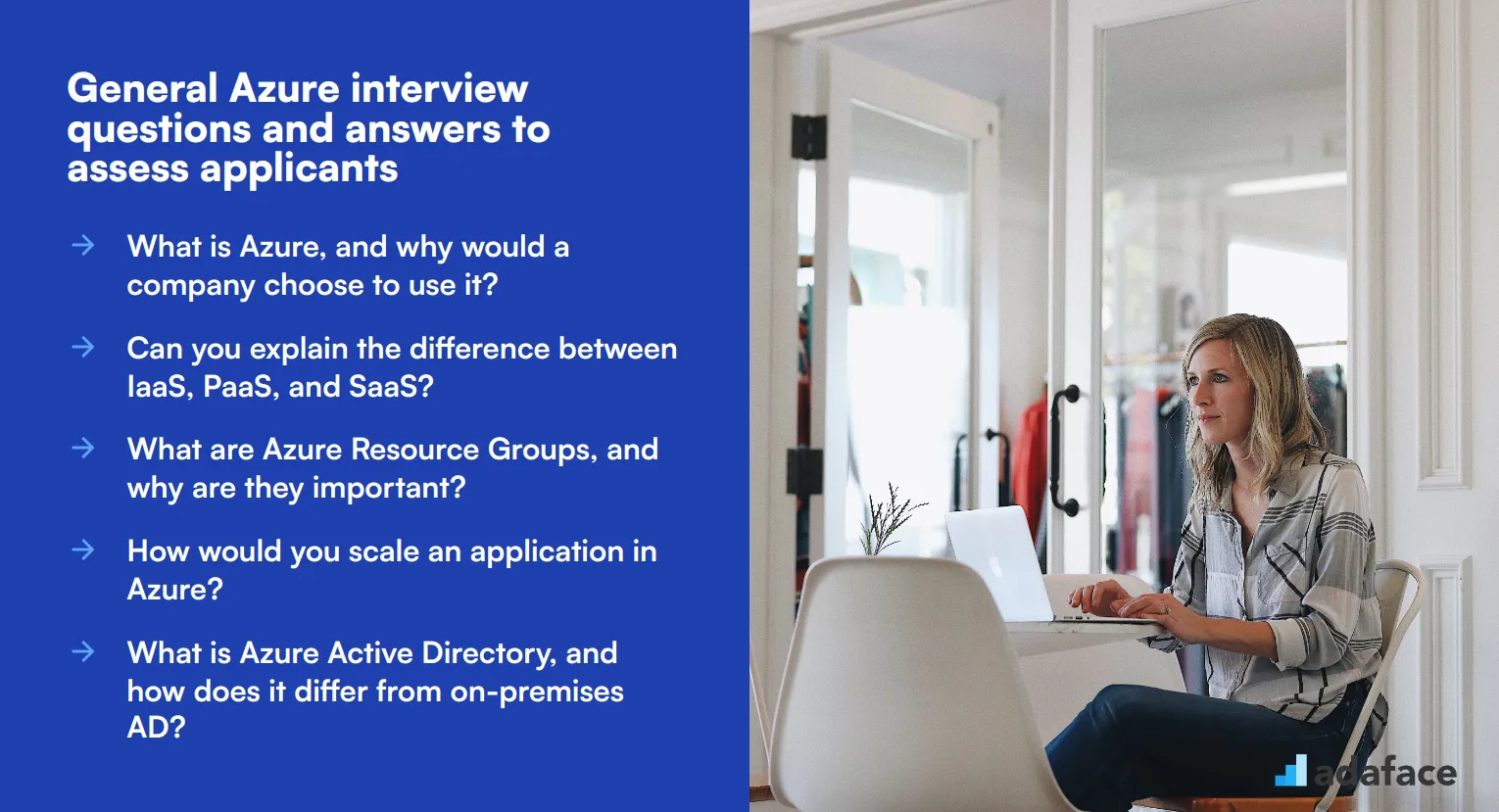
To determine if your applicants have the right knowledge and skills to work with Microsoft Azure, use these nine general Azure interview questions. They’ll help you gauge their understanding of key concepts and their ability to apply them in real-world scenarios.
1. What is Azure, and why would a company choose to use it?
Azure is Microsoft's cloud computing platform that offers a wide range of services, including storage, computing power, and networking. Companies choose Azure for its flexibility, scalability, and cost-effectiveness.
An ideal candidate should mention specific benefits such as ease of integration with other Microsoft services, global reach with multiple data centers, and robust security features. Look for answers that demonstrate an understanding of how Azure can solve specific business problems.
2. Can you explain the difference between IaaS, PaaS, and SaaS?
IaaS (Infrastructure as a Service) provides virtualized computing resources over the internet. PaaS (Platform as a Service) offers hardware and software tools over the internet, typically for application development. SaaS (Software as a Service) delivers software applications over the internet, on a subscription basis.
Candidates should be able to explain how each model serves different needs. For example, IaaS for more control over the infrastructure, PaaS for ease of development, and SaaS for end-user applications. Look for clarity in their explanation and examples of when each model would be used.
3. What are Azure Resource Groups, and why are they important?
Azure Resource Groups are containers that hold related resources for an Azure solution. They help manage and organize resources like virtual machines, storage accounts, and virtual networks.
A strong answer will highlight the benefits of resource groups in terms of management, organization, and access control. Look for candidates who can explain how resource groups simplify resource management and allow for more efficient deployments.
4. How would you scale an application in Azure?
Scaling an application in Azure involves adjusting the resources allocated to it based on demand. This can be done manually or automatically using Azure's auto-scaling features.
Candidates should mention key aspects like vertical scaling (increasing the size of an existing resource) and horizontal scaling (adding more instances of a resource). Look for an understanding of the cost implications and the monitoring tools available in Azure for scaling.
5. What is Azure Active Directory, and how does it differ from on-premises AD?
Azure Active Directory (Azure AD) is a cloud-based identity and access management service. It helps employees sign in and access resources in various services, like Microsoft 365, the Azure portal, and other SaaS applications.
Unlike on-premises Active Directory, Azure AD is designed for the cloud and offers features like SSO (Single Sign-On), MFA (Multi-Factor Authentication), and integration with thousands of SaaS applications. An ideal response should cover these differences and the advantages of using Azure AD in a cloud environment.
6. What are Azure Functions, and when would you use them?
Azure Functions are a serverless compute service that lets you run event-driven code without having to manage infrastructure. They are ideal for tasks that require minimal compute resources and can be triggered by various events, such as HTTP requests, timers, and messages from other Azure services.
Look for candidates to explain scenarios where Azure Functions can be beneficial, such as processing data streams, running scheduled tasks, and integrating with other Azure services. The focus should be on the flexibility and cost-efficiency of serverless computing.
7. Can you describe what Azure DevOps is and its core components?
Azure DevOps is a set of development tools and services designed to support the entire software development lifecycle. Its core components include Azure Repos (version control), Azure Pipelines (CI/CD), Azure Boards (work tracking), Azure Test Plans (testing), and Azure Artifacts (package management).
Candidates should demonstrate an understanding of how these components work together to streamline development processes from planning to deployment. Look for practical examples of how they have used these tools in previous projects.
8. What is the role of Azure Policy, and how does it help in managing resources?
Azure Policy is a service in Azure that allows you to create, assign, and manage policies to enforce rules and ensure compliance across your resources. It helps in maintaining governance and security by auditing and restricting actions that do not comply with your organization's standards.
Strong answers should include examples of how policies can be used to control costs, manage resource consistency, and ensure compliance with regulatory requirements. Look for candidates who can explain the practical benefits of using Azure Policy in a business context.
9. How do you ensure the security of data in Azure?
Securing data in Azure involves a multi-layered approach, including encryption (both in-transit and at-rest), identity and access management (using Azure Active Directory), and network security (using firewalls and security groups).
Candidates should discuss best practices like enabling Azure Security Center, using Azure Key Vault for managing secrets, and implementing multi-factor authentication. Look for a comprehensive understanding of various security features and how they can be utilized to protect data effectively.
20 Azure interview questions to ask junior cloud engineers
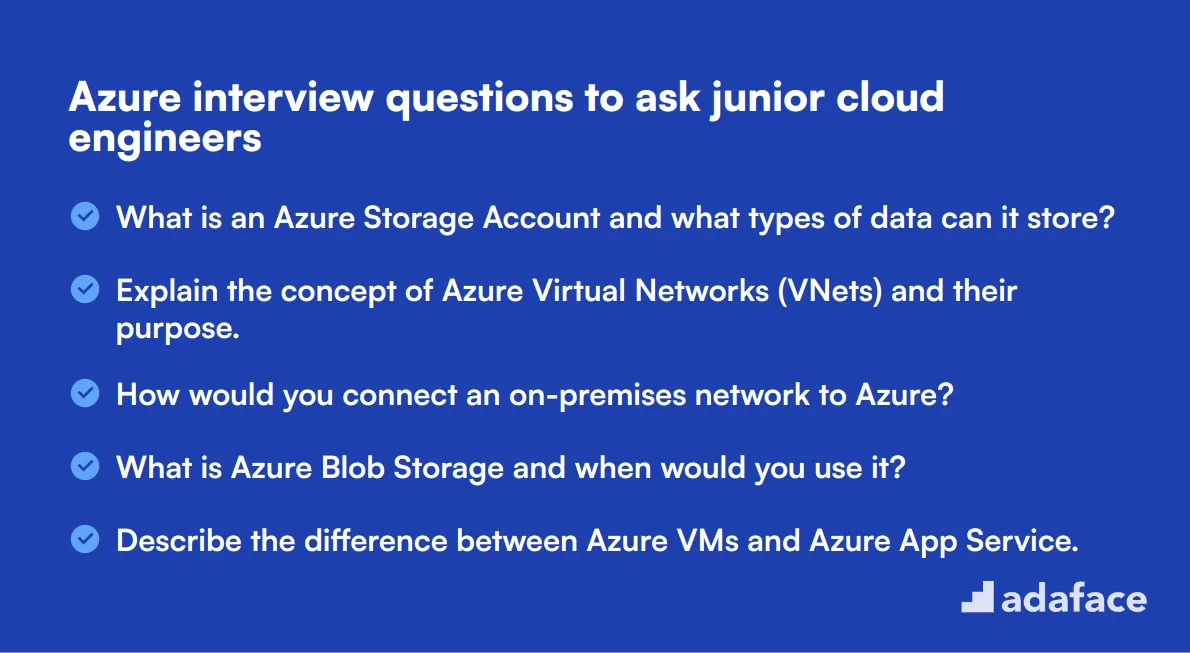
When interviewing junior cloud engineers, it's crucial to assess their foundational knowledge of Azure. Use these questions to gauge their understanding of basic concepts, services, and best practices. This list helps you identify candidates with the potential to grow into skilled Azure professionals.
- What is an Azure Storage Account and what types of data can it store?
- Explain the concept of Azure Virtual Networks (VNets) and their purpose.
- How would you connect an on-premises network to Azure?
- What is Azure Blob Storage and when would you use it?
- Describe the difference between Azure VMs and Azure App Service.
- What is Azure Key Vault and why is it important?
- Explain the purpose of Azure Traffic Manager.
- How does Azure Load Balancer differ from Azure Application Gateway?
- What is Azure Cosmos DB and what are its main features?
- Describe the process of deploying a web application to Azure App Service.
- What is Azure Monitor and how can it be used?
- Explain the concept of Azure Availability Sets.
- What are Azure Service Principal and Managed Identities?
- How would you secure access to an Azure SQL Database?
- What is Azure Container Instances and when would you use it?
- Describe the purpose of Azure Logic Apps.
- What is Azure Content Delivery Network (CDN) and how does it work?
- Explain the concept of Azure role-based access control (RBAC).
- What is Azure Backup and how does it differ from Azure Site Recovery?
- How would you troubleshoot a slow-performing Azure VM?
10 intermediate Azure interview questions and answers to ask mid-tier cloud engineers.
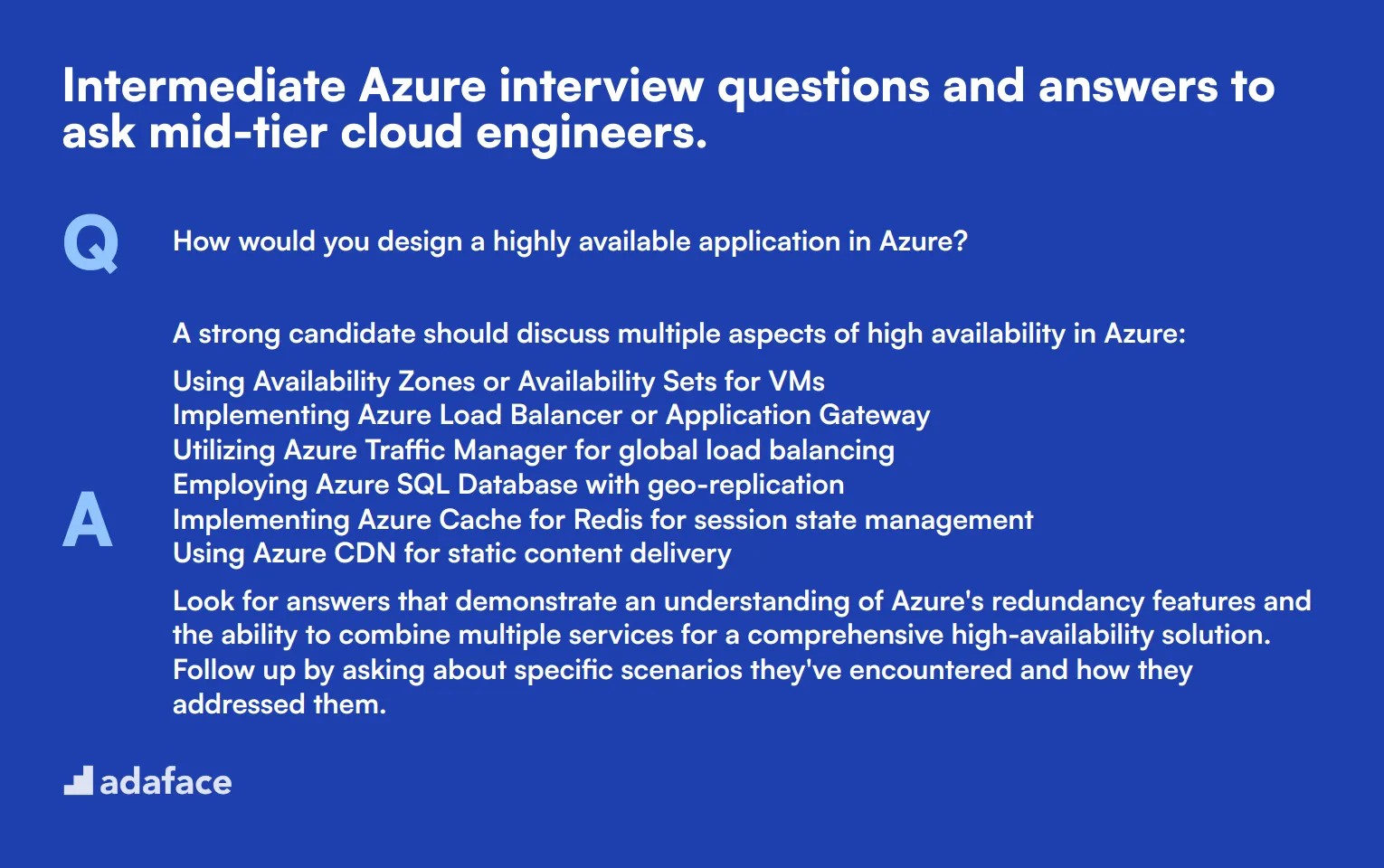
Ready to dive into the azure waters of mid-tier cloud engineering? These 10 intermediate Azure interview questions will help you gauge a candidate's depth of knowledge and practical experience. Use them to assess how well potential hires can navigate the complexities of Azure's services and architecture, and identify those who can truly cloud engineer their way to success.
1. How would you design a highly available application in Azure?
A strong candidate should discuss multiple aspects of high availability in Azure:
- Using Availability Zones or Availability Sets for VMs
- Implementing Azure Load Balancer or Application Gateway
- Utilizing Azure Traffic Manager for global load balancing
- Employing Azure SQL Database with geo-replication
- Implementing Azure Cache for Redis for session state management
- Using Azure CDN for static content delivery
Look for answers that demonstrate an understanding of Azure's redundancy features and the ability to combine multiple services for a comprehensive high-availability solution. Follow up by asking about specific scenarios they've encountered and how they addressed them.
2. Explain the differences between Azure Blob Storage, Azure Files, and Azure Disk Storage.
A knowledgeable candidate should be able to differentiate these storage options:
- Azure Blob Storage: Object storage for unstructured data like documents, videos, and backups. Accessible via HTTP/HTTPS and ideal for large-scale data.
- Azure Files: Fully managed file shares accessible via SMB protocol. Suitable for lift-and-shift scenarios and shared application settings.
- Azure Disk Storage: Block-level storage volumes for Azure VMs. Used as a physical disk for the OS and to store application data.
Look for answers that not only define each service but also provide use cases. A strong candidate might also mention performance tiers and integration capabilities with other Azure services.
3. How would you implement a disaster recovery solution for an Azure-based application?
An experienced candidate should outline a comprehensive disaster recovery strategy:
- Assess the application's Recovery Time Objective (RTO) and Recovery Point Objective (RPO)
- Use Azure Site Recovery for replicating VMs to a secondary region
- Implement geo-replication for Azure SQL Database or Cosmos DB
- Utilize Azure Traffic Manager or Front Door for failover routing
- Set up Azure Backup for regular backups of critical data
- Implement Azure Monitor and Azure Automation for monitoring and automated recovery
Look for answers that demonstrate understanding of Azure's disaster recovery services and the ability to create a holistic strategy. Ask about their experience in testing and maintaining DR plans.
4. What is Azure Service Fabric, and when would you choose it over Azure Kubernetes Service?
A well-informed candidate should explain Azure Service Fabric as a distributed systems platform used to build scalable and reliable microservices. They should mention its key features:
- Built-in support for stateful and stateless microservices
- Automated scaling and self-healing capabilities
- Support for multiple programming models (Reliable Services, Reliable Actors)
- Integrated with Visual Studio for easy development and debugging
Regarding choosing Service Fabric over AKS, look for answers that highlight scenarios where Service Fabric excels, such as applications requiring strong data consistency, complex stateful services, or when leveraging the Actor programming model. A good candidate might also mention that Service Fabric can be a better choice for teams already familiar with .NET and Windows environments.
5. How does Azure Front Door differ from Azure Application Gateway?
A knowledgeable candidate should be able to distinguish between these two services:
Azure Front Door:
- Global service for routing traffic across regions
- Provides global load balancing and multi-region failover
- Includes Web Application Firewall (WAF) capabilities
- Optimizes routing for best performance and quick global failovers
Azure Application Gateway:
- Regional service for load balancing HTTP(S) traffic
- Provides SSL termination, cookie-based session affinity, and URL path-based routing
- Includes Web Application Firewall (WAF) capabilities
- Operates at layer 7 (application layer) of the OSI model
Look for answers that not only describe the services but also provide use cases. A strong candidate might mention that Front Door is ideal for global applications requiring multi-region load balancing, while Application Gateway is better suited for intra-region load balancing and more advanced routing capabilities within a single region.
6. Explain the concept of Azure Managed Identities and how they enhance security.
A security-conscious candidate should describe Azure Managed Identities as a feature that provides Azure services with an automatically managed identity in Azure AD. They should explain its benefits:
- Eliminates the need for storing credentials in code or configuration files
- Automatically rotates credentials
- Can be used to authenticate to any service that supports Azure AD authentication
- Simplifies key management in both user-assigned and system-assigned scenarios
Look for answers that demonstrate understanding of how Managed Identities integrate with various Azure services like VMs, App Services, and Functions. A strong candidate might also discuss how Managed Identities contribute to the implementation of the principle of least privilege in Azure environments.
7. How would you optimize costs in an Azure environment without compromising performance?
An cost-conscious Azure professional should mention several strategies:
- Right-sizing resources: Use Azure Advisor to identify underutilized resources
- Leveraging Azure Reserved Instances for predictable workloads
- Implementing auto-scaling to match demand
- Using Azure Hybrid Benefit for Windows Server and SQL Server licenses
- Monitoring and optimizing storage usage
- Utilizing Azure Cost Management for budgeting and forecasting
- Implementing proper tagging for cost allocation and tracking
Look for answers that balance cost optimization with performance considerations. A strong candidate might also discuss their experience in implementing these strategies and the challenges they've faced. Ask about specific tools or scripts they've used for cost optimization.
8. Describe the process of implementing a blue-green deployment in Azure.
A candidate with deployment experience should outline the following steps:
- Set up two identical production environments (Blue and Green)
- Direct all traffic to the Blue environment initially
- Deploy the new version to the Green environment
- Conduct testing on the Green environment
- Gradually shift traffic from Blue to Green using Azure Traffic Manager or Application Gateway
- Monitor for any issues during the transition
- If successful, decommission the Blue environment; if not, quickly revert traffic back to Blue
Look for answers that demonstrate understanding of the benefits of blue-green deployments, such as reduced downtime and easy rollback. A strong candidate might also discuss how they've implemented this in Azure using specific services like App Services with deployment slots or Azure Kubernetes Service.
9. How does Azure ExpressRoute work, and when would you recommend using it?
A networking-savvy candidate should explain that Azure ExpressRoute provides a private, dedicated connection between on-premises networks and Azure, bypassing the public internet. They should mention key aspects:
- Offers higher reliability, faster speeds, and lower latencies than typical internet connections
- Supports various connectivity models: CloudExchange Co-location, Point-to-Point Ethernet, and Any-to-Any connections
- Provides layer 3 connectivity between on-premises network and Azure through a connectivity provider
Regarding recommendations, look for answers that suggest using ExpressRoute for scenarios requiring high bandwidth, consistent low latency, or for regulatory compliance reasons where data must not traverse the public internet. A strong candidate might also discuss the cost implications and the process of setting up an ExpressRoute connection.
10. Explain the concept of Azure Availability Zones and how they differ from Availability Sets.
A candidate with a solid understanding of Azure's high-availability features should explain:
Azure Availability Zones:
- Physically separate datacenters within an Azure region
- Each zone has independent power, cooling, and networking
- Protect against datacenter-level failures
- Typically used for mission-critical applications
Azure Availability Sets:
- Logical grouping of VMs within a single datacenter
- Protect against hardware failures and planned maintenance events
- Use update domains and fault domains to spread VMs across different racks
Look for answers that not only define these concepts but also discuss their appropriate use cases. A strong candidate might mention that Availability Zones offer higher availability but may have slightly higher latency between zones, while Availability Sets are suitable for applications that don't require region-wide protection.
10 Azure questions related to services and architecture
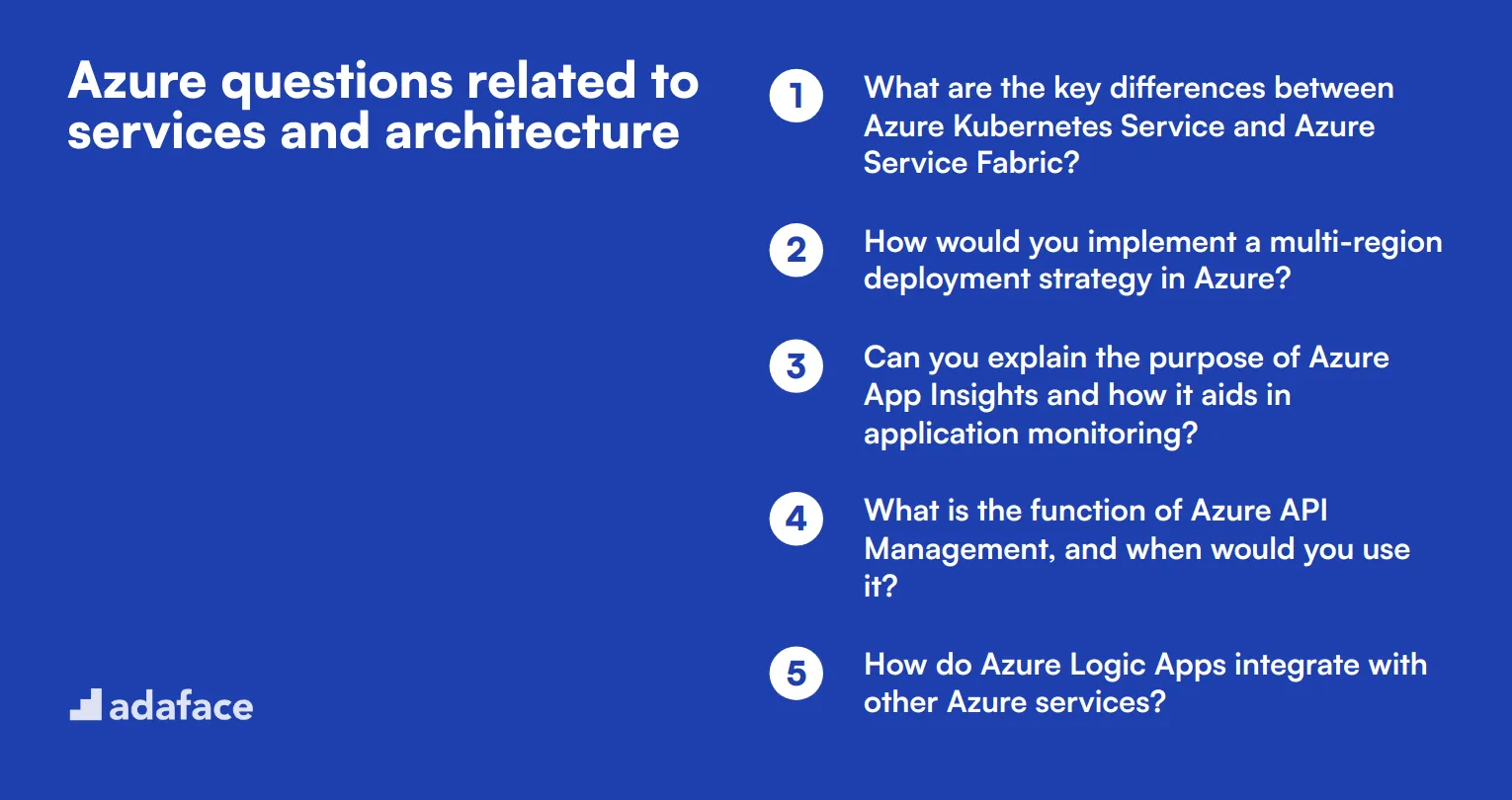
To evaluate candidates' understanding of Azure services and architecture, utilize these focused questions during the interview process. They will help you gauge whether the applicant possesses the necessary skills for roles such as Azure Developer or Cloud Architect.
- What are the key differences between Azure Kubernetes Service and Azure Service Fabric?
- How would you implement a multi-region deployment strategy in Azure?
- Can you explain the purpose of Azure App Insights and how it aids in application monitoring?
- What is the function of Azure API Management, and when would you use it?
- How do Azure Logic Apps integrate with other Azure services?
- What is Azure Synapse Analytics, and how does it differ from Azure Data Lake?
- Can you describe the benefits of using Azure Data Factory for data integration?
- What are Azure Automation runbooks, and in what scenarios would you employ them?
- How do you manage version control in Azure DevOps pipelines?
- What is Azure Front Door's role in enhancing application performance and security?
9 Azure interview questions and answers related to security practices
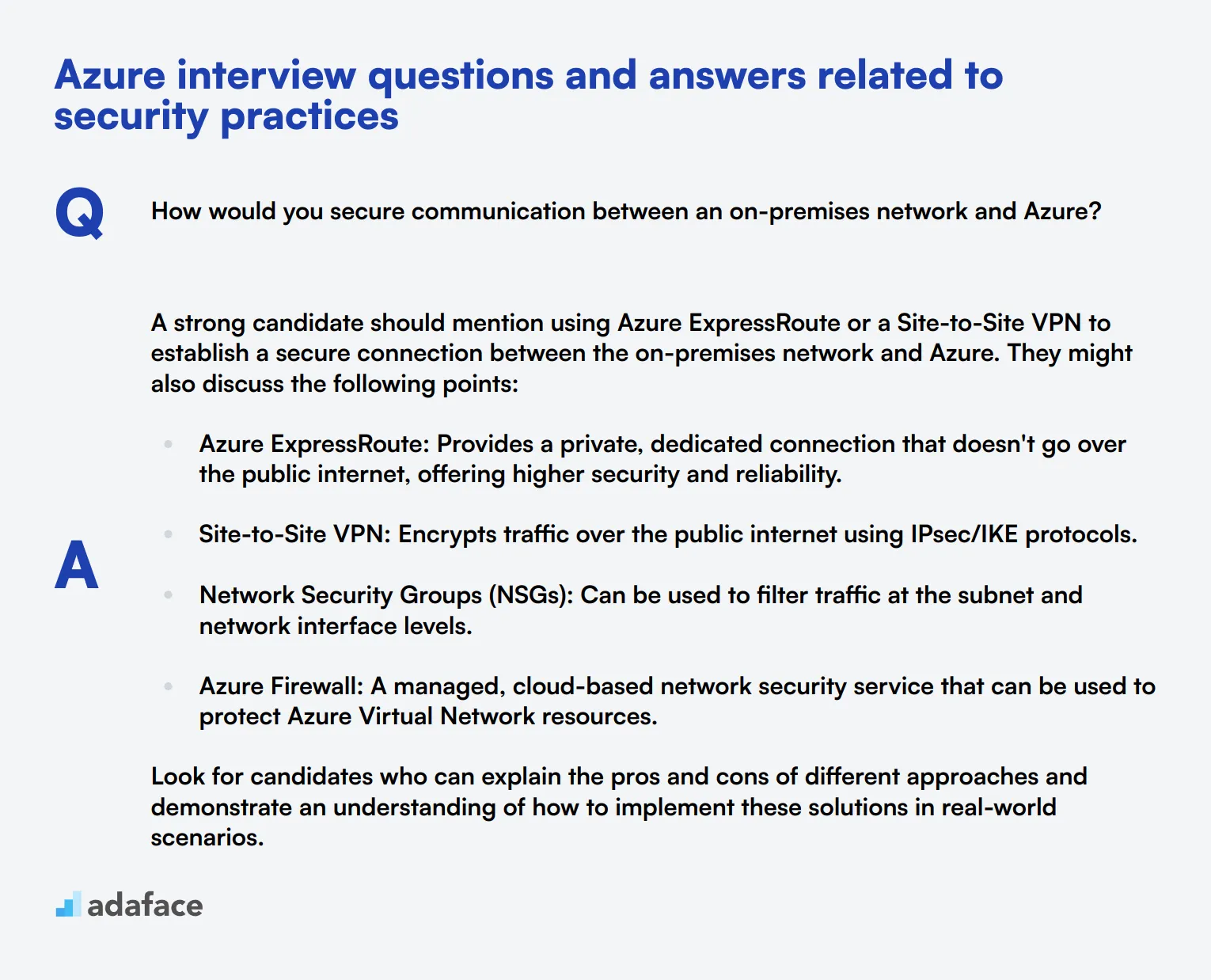
When it comes to Azure security, knowing the right questions to ask can make or break your hiring process. These 9 Azure interview questions related to security practices will help you gauge a candidate's understanding of cloud security and their ability to protect data in Azure environments. Use these questions to spark meaningful discussions and assess a candidate's practical knowledge of Azure security.
1. How would you secure communication between an on-premises network and Azure?
A strong candidate should mention using Azure ExpressRoute or a Site-to-Site VPN to establish a secure connection between the on-premises network and Azure. They might also discuss the following points:
- Azure ExpressRoute: Provides a private, dedicated connection that doesn't go over the public internet, offering higher security and reliability.
- Site-to-Site VPN: Encrypts traffic over the public internet using IPsec/IKE protocols.
- Network Security Groups (NSGs): Can be used to filter traffic at the subnet and network interface levels.
- Azure Firewall: A managed, cloud-based network security service that can be used to protect Azure Virtual Network resources.
Look for candidates who can explain the pros and cons of different approaches and demonstrate an understanding of how to implement these solutions in real-world scenarios.
2. What is Azure Conditional Access and how does it enhance security?
Azure Conditional Access is a feature of Azure Active Directory that allows organizations to enforce specific access controls based on certain conditions. A good answer should cover the following points:
- Conditional Access policies are if-then statements that enforce additional security measures when certain conditions are met.
- Common conditions include user or group membership, IP location, device platform, and detected risks.
- Actions can include requiring multi-factor authentication, blocking access, or requiring a compliant device.
An ideal candidate should be able to provide examples of how Conditional Access can be used to enhance security, such as requiring MFA for access from unfamiliar locations or blocking access from countries where the company doesn't operate. Look for answers that demonstrate an understanding of balancing security with user experience.
3. Explain the concept of Azure Privileged Identity Management (PIM) and its benefits.
Azure Privileged Identity Management (PIM) is a service that enables organizations to manage, control, and monitor access to important resources in Azure AD, Azure, and other Microsoft Online Services. A comprehensive answer should include:
- PIM provides just-in-time privileged access to Azure AD and Azure resources.
- It allows organizations to minimize the number of people who have access to secure information or resources.
- PIM offers features like time-bound access, approval workflows, and access reviews.
- It helps in enforcing the principle of least privilege and reduces the risk of cyber attacks.
Look for candidates who can explain how PIM can be implemented in real-world scenarios and its impact on an organization's security posture. They should also be able to discuss the balance between security and operational efficiency when using PIM.
4. How would you secure data at rest in Azure?
Securing data at rest in Azure involves several key technologies and practices. A strong candidate should mention:
- Azure Storage Service Encryption (SSE): Automatically encrypts data before persisting it to Azure Storage and decrypts it upon retrieval.
- Azure Disk Encryption: Uses BitLocker for Windows VMs and dm-crypt for Linux VMs to encrypt OS and data disks.
- Azure Key Vault: Securely stores and manages cryptographic keys and secrets used by cloud apps and services.
- Transparent Data Encryption (TDE): Encrypts SQL Server, Azure SQL Database, and Azure Synapse Analytics data files.
An ideal response would also touch on the importance of proper key management and rotation practices. Look for candidates who understand the different encryption options available and can explain when to use each one based on specific use cases or compliance requirements.
5. What is Azure Security Center and how does it help in maintaining security?
Azure Security Center is a unified infrastructure security management system that strengthens the security posture of data centers and provides advanced threat protection across hybrid workloads. A good answer should cover:
- Continuous assessment: It assesses resources, subscriptions, and organizations for security issues.
- Security recommendations: Provides actionable recommendations to remediate security vulnerabilities.
- Threat protection: Uses advanced analytics and threat intelligence to detect and prevent threats.
- Regulatory compliance: Helps track compliance with various standards and regulations.
Look for candidates who can explain how Security Center integrates with other Azure services and how it can be used to improve an organization's overall security posture. They should also be able to discuss the difference between the free and standard tiers and when each might be appropriate.
6. How would you implement network segmentation in Azure?
Network segmentation in Azure is crucial for isolating and protecting resources. A comprehensive answer should include:
- Virtual Networks (VNets): Used to create isolated network environments.
- Subnets: Divide VNets into smaller segments for better organization and security.
- Network Security Groups (NSGs): Apply at the subnet or NIC level to control traffic flow.
- Azure Firewall: Provides centralized protection for VNet resources across subscriptions and VNets.
- Service Endpoints: Enable secure, direct connectivity to Azure services over the Azure backbone network.
An ideal candidate should be able to explain how these components work together to create a secure network architecture. Look for answers that demonstrate an understanding of the principle of least privilege and how to apply it in network design.
7. What is Azure DDoS Protection and when would you recommend using it?
Azure DDoS Protection is a service designed to help protect Azure resources from Distributed Denial of Service (DDoS) attacks. A strong answer should cover:
- Basic protection: Automatically enabled for all Azure customers at no additional cost.
- Standard protection: Provides enhanced DDoS mitigation capabilities using adaptive tuning, attack analytics, and more.
- Always-on traffic monitoring: Continuously examines web traffic to detect potential DDoS attacks.
- Real-time mitigation: Automatically mitigates attacks when network traffic exceeds a threshold.
Candidates should recommend using Azure DDoS Protection Standard for critical business applications, especially those that are public-facing or mission-critical. Look for answers that demonstrate an understanding of the potential impact of DDoS attacks and the importance of proactive protection.
8. How does Azure AD B2B differ from Azure AD B2C, and when would you use each?
Azure AD B2B (Business-to-Business) and B2C (Business-to-Consumer) are both external identity services, but they serve different purposes:
- Azure AD B2B: Allows you to invite external users (partners, vendors, etc.) to access your organization's apps and resources. It's best for collaborative scenarios with other businesses.
- Azure AD B2C: Provides identity and access management for consumer-facing applications. It's designed to handle millions of users and billions of authentications per day.
Use B2B when you need to give external business partners access to your internal resources. Use B2C when building customer-facing applications that need to support various identity providers.
Look for candidates who can explain the security implications of each service and provide examples of appropriate use cases. They should also be able to discuss how these services integrate with other Azure security features.
9. Explain the concept of Azure Information Protection and its role in data security.
Azure Information Protection (AIP) is a cloud-based solution that helps organizations classify, label, and protect documents and emails. A comprehensive answer should include:
- Classification: Automatically or manually categorize data based on sensitivity.
- Labeling: Apply visual markers (headers, footers, watermarks) to indicate the data's classification.
- Protection: Encrypt sensitive data and define usage rights to control data access and sharing.
- Tracking: Monitor and control how protected data is being used.
An ideal candidate should be able to explain how AIP integrates with other Microsoft 365 services and its role in a comprehensive data protection strategy. Look for answers that demonstrate an understanding of data classification policies and how they can be implemented and enforced across an organization.
Which Azure skills should you evaluate during the interview phase?
In a single interview, it's nearly impossible to evaluate every aspect of a candidate's skills and knowledge. However, when it comes to hiring for Azure roles, there are several core skills that are paramount for success. Focusing on these key areas can help interviewers pinpoint the most capable candidates for cloud engineering positions.
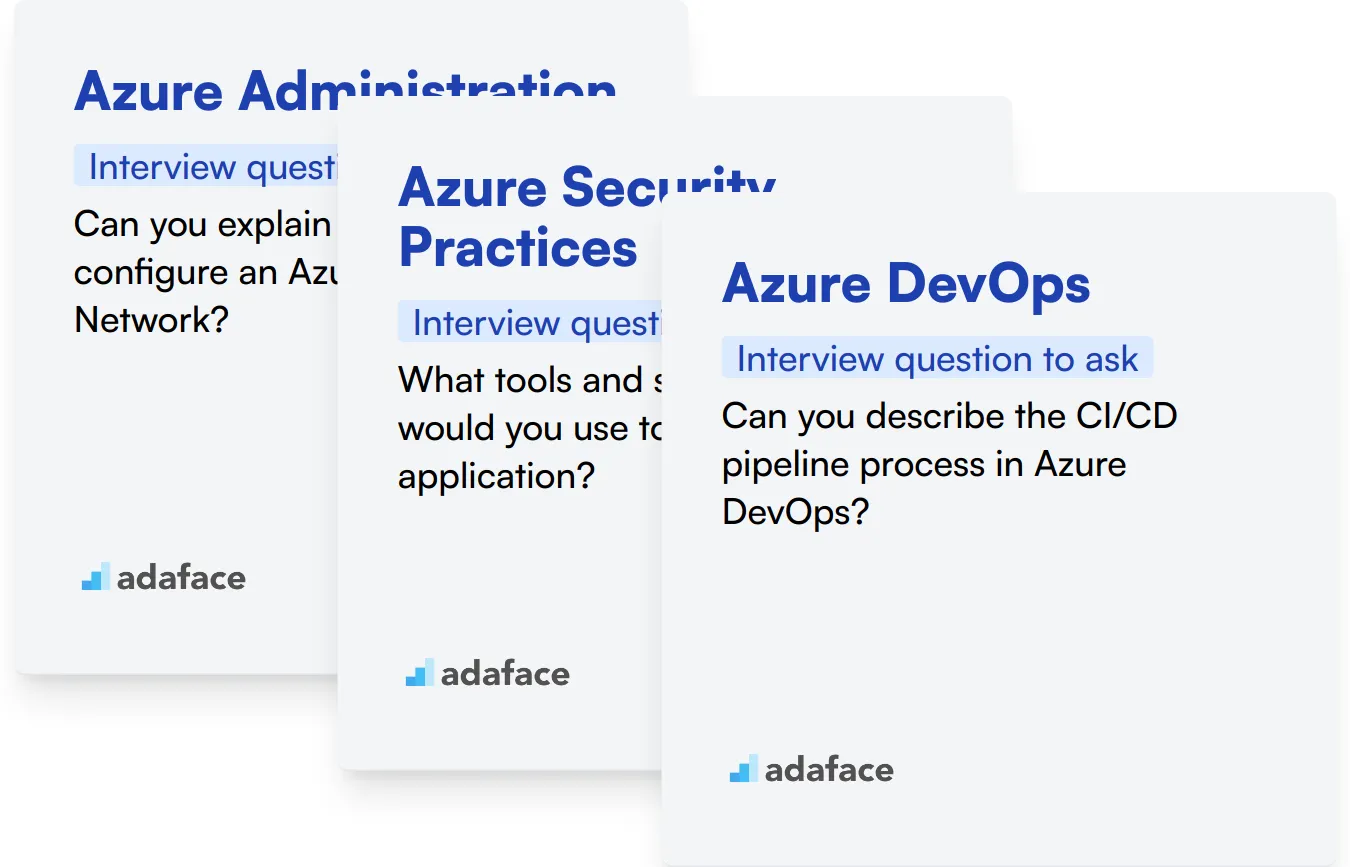
Azure Administration
To filter candidates effectively, consider utilizing an assessment test with relevant MCQs on Azure Administration. This can help identify those who truly grasp the complexities of managing Azure environments. You can explore the Azure test in our library for this purpose: Azure Online Test.
In addition to assessments, asking targeted interview questions can reveal the depth of a candidate's Azure Administration skills.
Can you explain the steps to configure an Azure Virtual Network?
Look for candidates who detail the configuration steps thoroughly, including subnet creation, security group rules, and connectivity options. A strong response will indicate a practical understanding of Azure networking.
Azure Security Practices
A strong method to evaluate this skill is through an assessment test that includes MCQs focused on Azure Security. Utilizing the Azure Online Test in your candidate evaluations can streamline this process.
To gain further insights, consider asking candidates a targeted question about Azure security.
What tools and services in Azure would you use to secure an application?
Watch for responses that mention Azure Security Center, Azure Active Directory, and network security groups. Candidates should demonstrate knowledge of integrated security measures available within Azure.
Azure DevOps
To filter candidates’ knowledge in this area, an assessment test with MCQs on Azure DevOps can be beneficial. Check out the Azure Online Test in our library for relevant content.
Moreover, targeted interview questions can help assess their practical experience with Azure DevOps.
Can you describe the CI/CD pipeline process in Azure DevOps?
Look for candidates to explain the stages of the pipeline, including build, test, and release. A detailed understanding of this process indicates a solid grasp of automating deployment workflows.
Hire top talent with Azure skills tests and the right interview questions
When hiring for Azure roles, it's important to ensure candidates possess the necessary skills. This will help you build a strong team that can effectively manage and utilize Azure services.
One of the best ways to accurately assess these skills is by using targeted skill tests. Consider using our Azure online test to gauge candidates' proficiency.
After administering the test, you can easily shortlist the best applicants for interviews. This streamlined process saves time and helps you focus on the most qualified candidates.
To get started, sign up for our platform today and access our range of assessments. Visit our test library for more information on available tests.
Microsoft Azure Online Test
Download Azure interview questions template in multiple formats
Azure Interview Questions FAQs
Ask a mix of general, service-specific, architecture, and security-related questions tailored to the candidate's experience level.
Prepare around 15-20 questions for a typical interview, selecting from the 62 questions provided based on the role and candidate's experience.
No, include a mix of technical and general questions to assess both Azure knowledge and overall cloud computing understanding.
Use the security-related questions provided to gauge the candidate's understanding of Azure security practices and protocols.
Yes, the questions are categorized for different experience levels, from junior to mid-tier cloud engineers and developers.

40 min skill tests.
No trick questions.
Accurate shortlisting.
We make it easy for you to find the best candidates in your pipeline with a 40 min skills test.
Try for freeRelated posts
Free resources




